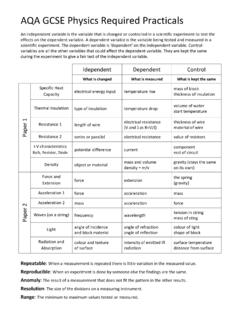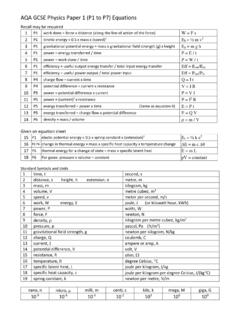Transcription of A student investigated how current varies with potential ...
1 A student investigated how current varies with potential difference for two different lamps. 1. Her results are shown in the figure below. (a) Complete the circuit diagram for the circuit that the student could have used to obtain the results shown in the figure above. (3). (b) Which lamp will be brighter at any potential difference? Explain your answer. Use the figure above to aid your explanation .. (2). Page 1 of 68. (c) Lamp B has the higher resistance at any potential difference. Explain how the figure above shows this.. (2). (d) Both lamps behave like ohmic conductors through a range of values of potential difference. Use the figure above to determine the range for these lamps. Explain your answer.. (3). (Total 10 marks). Page 2 of 68. An electrician is replacing an old electric shower with a new one. 2. The inside of the old shower is shown in Figure 1. Figure 1.
2 Michael Priest (a) If the electrician touches the live wire he will receive an electric shock. Explain why.. (4). Page 3 of 68. (b) Different electrical wires need to have a cross-sectional area that is suitable for the power output. Figure 2 shows the recommended maximum power input to wires of different cross- sectional areas. Figure 2. The new electric shower has a power input of kW. Determine the minimum diameter of wire that should be used for the new shower. The diameter, d, can be calculated using the equation: A is the cross-sectional area of the wire.. Minimum diameter = .. mm (2). Page 4 of 68. (c) The charge that flows through the new shower in 300 seconds is 18 000 C. The new electric shower has a power of kW. Calculate the resistance of the heating element in the new shower. Write down any equations you use.. Resistance = .. (5). (Total 11 marks). The current in a circuit depends on the potential difference ( ) provided by the cells and the 3 total resistance of the circuit.
3 (a) Using the correct circuit symbols, draw a diagram to show how you would connect V. cells together to give a of 6 V. (2). Page 5 of 68. (b) Figure 1 shows a circuit containing an 18 V battery. Two resistors, X and Y, are connected in series. X has a resistance of 3 . There is a current of 2 A in X. Figure 1. (i) Calculate the across X.. across X = .. V. (2). (ii) Calculate the across Y.. across Y = .. V. (2). (iii) Calculate the total resistance of X and Y.. Total resistance of X and Y = .. (2). Page 6 of 68. (c) Figure 2 shows a transformer. Figure 2. (i) An 18 V battery could not be used as the input of a transformer. Explain why.. (2). (ii) The transformer is 100% efficient. Calculate the output current for the transformer shown in Figure 2.. Output current = .. A. (2). (Total 12 marks). Page 7 of 68. (a) Figure 1 shows the apparatus used to obtain the data needed to calculate the resistance of 4 a thermistor at different temperatures.
4 Figure 1. Power supply (i) In the box below, draw the circuit symbol for a thermistor. (1). (ii) Use the data given in Figure 1 to calculate the resistance of the thermistor at 20 C.. Resistance = .. ohms (2). Page 8 of 68. (iii) Figure 2 shows the axes for a sketch graph. Complete Figure 2 to show how the resistance of the thermistor will change as the temperature of the thermistor increases from 20 C to 100 C. Figure 2. Temperature in C. (1). (iv) Which one of the following is most likely to include a thermistor? Tick ( ) one box. An automatic circuit to switch a plant watering system on and off. An automatic circuit to switch an outside light on when it gets dark. An automatic circuit to switch a heating system on and off. (1). (b) The ammeter used in the circuit has a very low resistance. Why is it important that ammeters have a very low resistance? .. (1). Page 9 of 68.
5 (c) The table below gives the temperature of boiling water using three different temperature scales. Temperature Scale 100 Celsius ( C). 212 Fahrenheit ( F). 80 R aumur ( Re). Scientists in different countries use the same temperature scale to measure temperature. Suggest one advantage of doing this.. (1). (d) A student plans to investigate how the resistance of a light-dependent resistor (LDR). changes with light intensity. The student starts with the apparatus shown in Figure 2 but makes three changes to the apparatus. One of the changes the student makes is to replace the thermistor with an LDR. Describe what other changes the student should make to the apparatus.. (2). (Total 9 marks). Page 10 of 68. The picture shows an electric cooker hob. The simplified circuit diagram shows how the four 5 heating elements connect to the mains electricity supply. The heating elements are identical.
6 When all four heating elements are switched on at full power the hob draws a current of 26 A. from the 230 V mains electricity supply. (a) Calculate the resistance of one heating element when the hob is switched on at full power. Give your answer to 2 significant figures.. Resistance = .. (3). Page 11 of 68. (b) The table gives the maximum current that can safely pass through copper wires of different cross-sectional area. Cross-sectional Maximum safe area in mm2 current in amps The power sockets in a home are wired to the mains electricity supply using cables containing mm2 copper wires. Most electrical appliances are connected to the mains electricity supply by plugging them into a standard power socket. It would not be safe to connect the electric cooker hob to the mains electricity supply by plugging it into a standard power socket. Why? .. (2). (c) Mains electricity is an alternating current supply.
7 Batteries supply a direct current . What is the difference between an alternating current and a direct current ? .. (2). (Total 7 marks). Page 12 of 68. (a) A student set up the circuit shown in the diagram. The student uses the circuit to obtain the 6 data needed to plot a current - potential difference graph for a diode. (i) Draw, in the boxes, the circuit symbol for a diode and the circuit symbol for a variable resistor. Diode Variable resistor (2). (ii) The student made two mistakes when setting up the circuit. What two mistakes did the student make? 1 .. 2 .. (2). Page 13 of 68. (b) After correcting the circuit, the student obtained a set of data and plotted the graph below. potential difference in volts (i) At what potential difference did the diode start to conduct an electric current ? .. V. (1). (ii) Use data from the graph to calculate the resistance of the diode when the potential difference across the diode is V.
8 Resistance = .. ohms (3). Page 14 of 68. (c) The diagram shows the trace produced by an alternating current ( ) supply on an oscilloscope. Each horizontal division on the oscilloscope screen represents a time of (i) Calculate the frequency of the supply.. Frequency = .. hertz (2). (ii) A diode is now connected in series with the power supply. Why does the diode cause the trace on the oscilloscope screen to change? .. (2). (Total 12 marks). Page 15 of 68. The diagram shows the structure of a cable. The cable is part of an undersoil heating circuit 7 inside a large greenhouse. (a) The cable is connected to the mains electricity supply through a residual current circuit breaker. If the cable is accidentally cut the circuit breaker automatically switches the circuit off. (i) What is the frequency of the mains electricity supply in the UK? .. (1). (ii) What happens, as the cable is cut, to cause the circuit breaker to switch the circuit off?
9 (2). (iii) A circuit can also be switched off by the action of a fuse. Give one advantage of using a circuit breaker to switch off a circuit rather than a fuse.. (1). (b) The 230 volt mains electricity supply causes a current of 11 amps to flow through the cable. (i) Calculate the amount of charge that flows through the cable when the cable is switched on for 2 hours and give the unit.. Charge = .. (3). Page 16 of 68. (ii) Calculate the energy transferred from the cable to the soil in 2 hours.. Energy transferred =.. J. (2). (c) The heating circuit includes a thermistor. The thermistor is buried in the soil and acts as a thermostat to control the increase in the temperature of the soil. Describe how an increase in the temperature of the soil affects the thermistor.. (2). (Total 11 marks). (a) The resistance of a 24 W, 12 V filament lamp depends on the current flowing through the 8 lamp.
10 For currents up to A, the resistance has a constant value of . (i) Use the equation in the box to calculate the potential difference across the lamp when a current of A flows through the lamp. potential difference = current resistance Show clearly how you work out your answer.. potential difference = .. V. (2). Page 17 of 68. (ii) When the potential difference across the lamp is 12 V, the current through the lamp is 2 A. On the axes below, draw a current potential difference graph for the filament lamp over the range of potential difference from 0 to 12 volts. (2). (iii) Why does the resistance of the lamp change when the current through the lamp exceeds A? .. (1). Page 18 of 68. (b) The lamp is now included in a circuit. The circuit is switched on for 2 minutes. During this time, 72 coulombs of charge pass through the lamp. Use the equation in the box to calculate the energy transformed by the lamp while the circuit is switched on.


